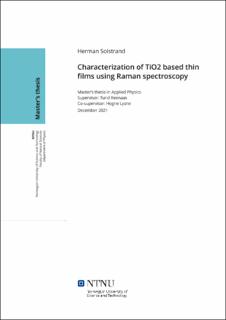| dc.contributor.advisor | Reenaas, Turid | |
| dc.contributor.advisor | Lysne, Hogne | |
| dc.contributor.author | Solstrand, Herman | |
| dc.date.accessioned | 2022-06-07T17:19:43Z | |
| dc.date.available | 2022-06-07T17:19:43Z | |
| dc.date.issued | 2021 | |
| dc.identifier | no.ntnu:inspera:97791640:31752279 | |
| dc.identifier.uri | https://hdl.handle.net/11250/2997781 | |
| dc.description.abstract | Strukturen til forskjellige TiO2-baserte tynnfilm-prøver ble studert ved bruk av Raman spektroskopi. Prøvene ble deponert på silisium-skiver med to-tommers diameter ved bruk av pulset laser deponering (PLD), og noen ble ko-dopet med Cr-N, for å mulig lage et mellombånd i båndgapet til TiO2. Ikke alle tynnfilm-prøvene ble grodd for å være uniforme over hele flaten av substratet, og prøvene har blitt kategorisert som enten «plume prøver (statisk substrat, deponert film representerer plasma-«plumen» under deponering), «film prøver» (roterende substrat, med mål om å gro en uniform film) eller «kombinatoriske prøver» (forskjellige «plumer» deponert på spesifikke posisjoner på substratet, for å lage en spesifikk konsentrasjonsgradient, og/eller tykkelsesgradient på tvers av tynnfilmen). Alle prøvene ble laget av Thomas Vågenes Brakstad og Hogne Lysne som del av deres PhD-forskning.
Målet med dette masterprosjektet var å studere hvordan gro-parameterne til disse tynnfilmene påvirker krystalliniteten deres, samt hvordan disse karakteristikkene varier på tvers av filmene, for å bedre koble observerte variasjoner til de forskjellige deponeringsparameterne.
Resultatene fra Raman spektroskopi viste at deposisjonsparameterne i stor grad påvirker krystalliniteten til de deponerte TiO2 tynnfilmene. Det ble oppdaget at både deponering hvor bakgrunns-gassen ble syklet mellom O2 og N2 og doping var svært ødeleggende for krystalliniteten til de deponerte filmene, og resulterte i amorfe strukturer med brede Raman-topper. De fleste filmer som var deponert kun med TiO2 og O2 bakgrunns-gass viste imidlertid spektre som kan bli tilegnet anatase-fasen til krystallinsk TiO2.
Andre faktorer som varierte innad i de krystallinske filmene, som film-tykkelse og avstand fra deposisjons-senteret, hadde mindre betydning for krystalliniteten til filmene. Begge disse faktorene skapte imidlertid variasjoner i tøyning på tvers av filmene, som førte til skift i Raman-toppene.
For filmene med amorfe strukturer viste de tilegnede Raman-spektrene seg å være vanskeligere å analysere i detalj, og de eksakte strukturene til disse filmene forblir uvisst. Fortsatt viste Raman-teknikken seg å være nyttig, ettersom oppdagelsen av amorfheten til disse filmene bidrar til nyttig informasjon i seg selv. | |
| dc.description.abstract | The structural characteristics of various TiO2 based thin film samples were studied using Raman spectroscopy. The samples were deposited on 2” silicon wafer substrates using pulsed laser deposition (PLD), and some were co-doped with Cr-N, to create a potential intermediate band in the band gap of TiO2. Not all thin film samples were grown to be uniform across the area of the substrate, and have been categorised as either “plume samples” (static substrate, deposited film representing the deposition plasma plume), “film samples}” (rotating substrate, aiming to deposit a uniform film) or “combinatorial samples” (different plumes deposited at specific positions on the substrate, to obtain a specific concentration and/or thickness gradient across the thin film). All samples were made by Thomas Vågenes Brakstad and Hogne Lysne as part of their PhD research.
The aim of this master project was to study how the growth conditions of these films affect their crystallinity, as well as how these characteristics vary across the films, to better link any observed variations to the different depositing parameters.
The results obtained through Raman spectroscopy showed that the deposition parameters largely affect the crystallinity of TiO2 in the deposited thin film. Both deposition with background gas cycling between O2 and N2 and doping was found to severely damage the crystallinity of the deposited films, resulting in amorphous structures with broadened Raman peaks. Most thin films deposited only with a TiO2 target and O2 background pressure did however reveal spectra that can be attributed to the anatase phase of crystalline TiO2.
Other factor that varied within the crystalline films, like film thickness and distance from deposition plume centre, had less of an impact on the crystallinity of the films. Both these factors did however cause variations in strain across the films, causing shifts in the Raman peaks.
For the films containing amorphous structures, the obtained Raman spectra proved more difficult to analyse in detail, and the exact structure of these films remain undetermined. Still, the Raman technique did prove to be useful, as the discovery of the amorphousness of these samples provide useful information in itself. | |
| dc.language | eng | |
| dc.publisher | NTNU | |
| dc.title | Characterization of TiO2 based thin films using Raman spectroscopy | |
| dc.type | Master thesis | |
